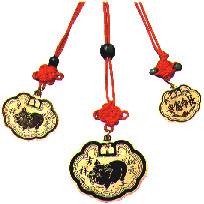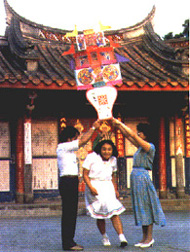Eine interessante Variante der Zhinü-Legende aus Taiwan erzählt, dass weder Niulang noch die beiden Kindern bei Zhinü im Himmel bleiben durften. Sie mußten wieder auf die Erde zurück, wo sie von Niulang, als alleinerziehendem Vater aufgezogen werden mußten. Niulang schien dabei etwas überfordert gewesen zu sein, da ihm Zhinü´s 6 Schwestern ( in Gestalt der Nachteule Caprimulgus indicus 蚊母鸟 wen2
-mu3-niao3 mosquito mother bird, nightjar; 彐夕力 yo-taka ; oder als Vogelmütter / Gluckhennen) zu Hilfe kamen und ihn dabei unterstützten. Zhinü hingegen wurde zur Schutzpatronin für alle Kinder der Welt.An interesting Taiwanese version of the Zhinü-legend has it, that neither Niulang nor the kids were allowed to stay with Zhinü in heaven. They had to return to earth where they had to be brought up by their father Niulang. But this job seemed to overcharge him as the six sisters of the weaving maid felt so sorry for the cowherd as he struggled to raise the kids alone that they brought a mother bird to protect the children. Meanwhile, Zhinü, who longed so much to see her own children, became transformed into Qiniangma, a patron deity for all children, ensuring that they grow to adulthood in health and safety
Auf Grund der früher hohen Säuglingssterblichkeit gab es in China (z.B.Jiangshu und Anhui Provinz), vorallem aber auf Taiwan den Brauch, die Kinder unter den persönlichen Schutz der Göttin Qiniangma zu stellen.
In the past, when medicine was not advanced, child mortality rates were high. Chinese, esp.Taiwanese mothers would bring their sons and daughters on their first birthday to be dedicated as the adopted children of Qiniangma.
Qiniangma 七娘妈 (Chiniangma, Chhit niu ma, Qi Xiannu 七仙女 ) ist die Weberprinzessin Zhinü, die mit ihren Schwestern in den sieben Sternen des Großen Wagens (斗 dou3
) wohnt. (Sie ist außer Schutzpatronin der Kinder auch Schutzgöttin der Weberinnen, allgemein der Bäuerinnen) Ihr Haupttempel ist der Kailung Tempel in Tainan, Taiwan. Mit ihr werden dort noch die Göttinnen Zhusheng Niangniang und Linshui Furen (Fruchtbarkeits- und Geburtsgöttinnen) verehrt. Ihr Hauptfest ist Qixi 七夕 (Chihsi; Diu Zhen / Tiu Chen) am 7.Tag des 7.(Mond)Monats.Qiniangma 七娘妈 (Chiniangma, Chhit niu ma, Qi Xiannu 七仙女 ) in fact is the weaving princess Zhinü residing, according to folk tradition, with her six sisters in the seven stars of the Big Dipper (斗 dou3
) . Her main temple is Kailung Temple at Tainan, Taiwan. Together with her, Zhusheng Niangniang and Linshui Furen (fertility and childbirth goddesses) are worshiped there. Their main festival is Qixi 七夕 (Chihsi; Diu Zhen / Tiu Chen) on the 7th day of the 7th lunar month.Am seinem ersten Geburtstag ( oder nach einem Monat) erhält das Kind ein Amulett (Kuan Tai) in Form einer alten Münze oder eines Medaillons, das an einem roten Seidenfaden (jiajuan) um den Hals getragen wird, und wird im (Kailung) Tempel unter den Schutz Qiniangma´s gestellt. Dieser Ritus heißt Kuan kuin und wird jährlich am 7.Tag des 7.Mondmonats durch Erneuerung des roten Fadens ( Uan kuin) vollzogen bis das Kind 16 Jahre alt ist.
On his first birthday (sometimes one month after birth) the child gets an amulet (Kuan Tai), an old coin or medaillion, to be worn on a red silken thread (jiajuan) around is neck. Presented at the (Kailung) temple it is given under the protection of Qiniangma. This rite is called Kuan kuin. It will be performed every year on the 7th day of the 7th lunar month by renewing the red thread (uan kuin) unless the child is 16 years old.


Mit Erreichung des 16.Lebensjahrs wird das Volljährigkeitsfest gefeiert (Ab dem Alter von 16 Jahren bekamen die Kinder für ihre Arbeit im Hafen von Tainan den vollen Lohn ausbezahlt). Der Faden wird zerrissen, das Amulett im Tempel zurückgegeben und Qiniangma für den bisherigen Schutz mit Opfergaben und einem Festmahl gedankt. Bei der Zeremonie im Tempel zieht der Jugendliche in drei Stufen ein immer festlicheres Gewand, Zhuangyuan, das Gewand der kaiserlichen Reifeprüfung, an, und bietet seinen Eltern kniend zum Dank Tee an. Danach geht er dreimal im Kreis unter der Qiniangma Pagode, einer Miniaturpagode, die von seinen Eltern hochgehalten wird, durch ohne zurück zu blicken. Zum Schluß muß er noch eine Tragestange mit Lastkörben auf seine Schultern nehmen.
When reaching the age of 16 the coming-of-age rite is celebrated. ( Children working at Tainan's harbour were paid their full wages at the age of 16. Thus, when children reached the age of 16, they were considered adults in the eyes of society and could help their parents take up the burden of supporting the family). The thread will be shed and the amulet given back at the temple thanking Qinaingma for her protection with different offerings and a meal. On the day of the ceremony, the child who had come of age would have to change into three different sets of clothing, called Zhuangyuan (the clothing worn by those who passed the highest grade of imperial examinations), and accompanying headgear. Through the changing into progressively finer and grander garments, the child would attain an inner transformation through an outer change of clothing. He or she will then kneel before their parents and thank them by performing the offering of tea. Afterwards at the conclusion of the sacrifice, the parents lift up the Qiniangma Pagoda to allow the children to pass under it. While passing underneath the pagoda, boys should circle it counterclockwise three times, while girls should circle it clockwise three times. The boys and girls should not look back but look forward, showing that they are bravely walking into the future. This is called 'leaving the mother birds nest'. The Qiniangma Pagoda is finely handcrafted out of bamboo pieces and paper strips. They come with two or three layers, with Qiniangma residing above, her six sisters residing in the middle, and throughout attached with images of the Eight Immortals or the mother birds who help Qiniangma to watch over children. At last the child, now adult, will have to take carrying poles balancing them.
For more detailled info also see: text 1, text 2

Dieses Volljährigkeitsfest wird jährlich am 7.Tag des 7.Mondmonats von vielen Jugendlichen im Kailung Tempel in Tainan gefeiert. Es geht bis in die Zeit der Xia (2100-1700 v.Chr.) und Shang Dynastien (1700-1100 v.Chr.) zurück und ist mit Geburt, Hochzeit und Begräbnis einer der vier Hauptriten.
This coming-of-age rite, which was also called the "capping rite" or the "hairpin rite" in ancient times, can be traced back to the Xia (2100-1700 BCE) and Shang Dynasties (1700-1100 BCE). Along with birth, marriage, and funerals, it is considered one of the four major rites.
Die genannten religiösen Bräuche erinnern an ähnliche in der abendländisch-katholischen Kultur: Taufpatin, Namenspatron sowie Firmung / Konfirmation.
These religious customs remind one of similar ones in occidental-catholic culture: godmother, surname saint and Firmung / ceremony of confirmation
Bei der Taufe binnen Monatsfrist nach der Geburt übernimmt die Taufpatin eine besondere Verpflichtung für das Gedeihen des Kindes, schenkt ihm ein Amulett (Kreuz) an einem Goldkettchen und stellt es unter den Schutz eines/r Heiligen, des Namenspatrons/patronin. In Märchen wird von ebensolchen nicht-christlichen Riten bei der Namensgebung berichtet.
At baptism a month after birth the godmother (or godfather) takes patronage for the child and gives an amulet (crucifix) to be worn around the neck to the child. The child is given under protection of the saint who's name is given the child as surname. There are similar pagan ceremonies.
Im Folgenden seien westliche Parallelen zu den 3 Göttinnnen Qiniangma (Zhinü), Zhusheng Niangniang (Fruchtbarkeits- und Geburtsgöttin) und Linshui Furen (Göttin die das Wasser überwacht) aufgezeigt:
Western counterparts to the three goddesses Qiniangma (Zhinü), Zhusheng Niangniang (goddess of fertility and childbirth) und Linshui Furen (goddess looking over the water)
1. Die Matronen
1. Matrones
Germanische (steinzeitliche) Erd-, Sonnen- und Mondmütter/göttinnen. Es sind Göttinnen, die die Dreifaltigkeit symbolisieren. Sie entsprechen den 3 Bethen. Auf Reliefs tragen die beiden äußeren Matronen auf germanischem Boden "Hauben" (= Sonnen- und Mondscheibe). Woanders jedoch nie: von römischen Soldaten außerhalb Germaniens verpflanzt, wurden sie dort zu segenspendenden Fruchtbarkeitsgöttinnen.
Germanic (neolithic) Earth, Sun and Moon Goddesses. They are goddesses symbolizing trinity (the three aspects of the Universal Goddess as maiden, mother and crone). Their later manifestation are the Bethen.
2. Die 3 Bethen (Jungfrauen, Fräulein):
2. The 3 Bethen (sacred virgins, 'Fräulein'):
Sie helfen Frauen bei Kinderlosigkeit, in Kindsnöten, kommen nach der Geburt an die Wiege, verrichten Arbeiten u.a. Spinnen, tun Krankendienste und eröffnen verborgene Schätze.
They help women in cases of infertility and when giving birth. After birth they appear at the cradle. They help with homework i.e spinning and weaving, serve as nurses and unveil hidden treasures.
Zhinü scheint Ambet zu entsprechen, da sie in bildlichen Darstellungen der Dreiergruppe stets herausgehoben wird. Sie wird immer mit einer Kette (Halskette, Perlenkette) dargestellt.
Zhinü seems to be an equivalent of Ambeth.
Die Silbe Am bzw. An soll mit an-u = Mutter zusammenhängen. Ambet wird als Personifikation der jungfräulich-mütterlichen Erde gesehen. Der mit ihr in Verbindung stehende Flur- oder Personenname enthält An-. Ihr christliches Pendent ist (Mutter) Anna, die Patronin der Schwangeren und Gebärenden (s.Anna Selbdritt) und die Nothelferin Hl.Katharina.
Ambeth is the personification of the virgin-maternal earth. Her Christian counterparts are (mother) Anne (Anna), the patroness of pregnant and women in labour (see also: Maria Selbdritt / trifold Anna) and helper in need Saint Catherine
Wil in Wilbet bedeutet Scheibe, konkret die Mondscheibe. Wil steht auch mit Zeit, Zeitpunkt in Verbindung. Wilbet ist die Mondmutter, von der Wachsen und Gedeihen abhängt. Sie spendet Fruchtbarkeit, ihr Tier ist der Hase ( siehe: chinesische Mondhäsin Yue tu ). Sie ist auch die Beschützerin schwangerer Frauen. Der mit ihr in Verbindung stehende, Schutz und Segen verheissende Personenname enthält Wil-. Ihr christl.Pendent ist (die jungfräulche GottesMutter) Maria und die Nothelferin Hl.Margarethe.
Wil of Wilbet means wheel (wheel of time) and disc, the moondisc resp. So Wilbet ist the moon mother who affects growing and prospering. As she grants fertility, her holy animal ist the rabbit (take note: Chinese moon rabbit Yue tu). Wilbet also protects pregnant women. Her Christian counterparts are Virgin Mary and helper in need Saint Margaret.
Bor in Borbet bedeutet Wärme, strahlendes Licht und Höhe. Borbet ist die mütterliche Sonne. Ihr ist das Sonnenkälbchen (Marienkäfer) heilig, sie ist mit dem Osten (Sonnenaufgang) verortet. Mit ihr in Verbindung stehende Personennamen sind —bert und —brecht. Ihr christl.Pendent ist die heilige Barbara (Babett).
Bor of Borbet means warmth, light. So Borbet is the maternal sun. Her Christian counterpart is Saint Barbara.
3. Hl. Mutter Anna Selbdritt (Holy mother Anne 'as three')
4. Die 3 Jungfrauen unter den 14 Nothelfern:
Ein bairischer Reim lautet: Barbara mit dem Turm, Margarethe mit dem Wurm, Katharina mit dem Radl, das sind die drei heiligen Madel.
A Bavarian verse reads: Barbara with the tower, Margaret with the worm, Catherine with the wheel, those are the holy three girls.
Barbara, Bärbel (Borbet), Strahlensonne auf der Brust, Sonne, Sonnenmutter
St.Barbara, mother sun
Margarethe/Wurm (Marina, Juliana, Lady of Linshui furen), Mond-kalp, Mond (Frau Rötte), Mondfrau
St.Margaret, moon woman
Katharina, Käthe, Kett-kalp, Erde, Erdmutter
St.Catherine, earth mother
5. Dreigestaltige Göttinnen als Ausformung der Großen Göttin gab es im Nahen Osten, in Griechenland, bei den Römern, bei den Kelten und in Nordeuropa. Die Dreifaltigkeit ist ein weitverbreitetes religiöses Phänomen.
Triple goddesses as an incorporation of the Great Goddess are found in Near East, Greece, at the Romans, the Celts and in Northern Europe. So this is a wide spread religious phenomenon.